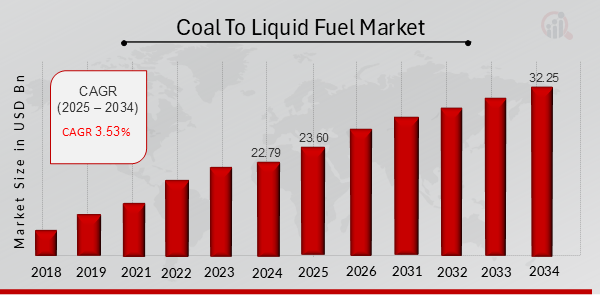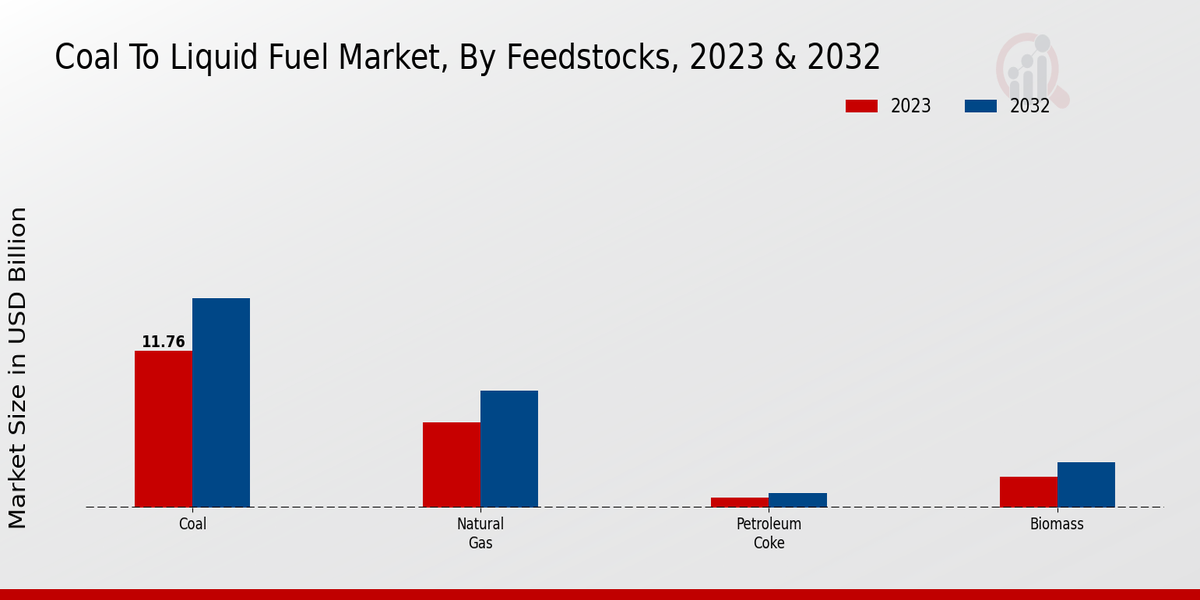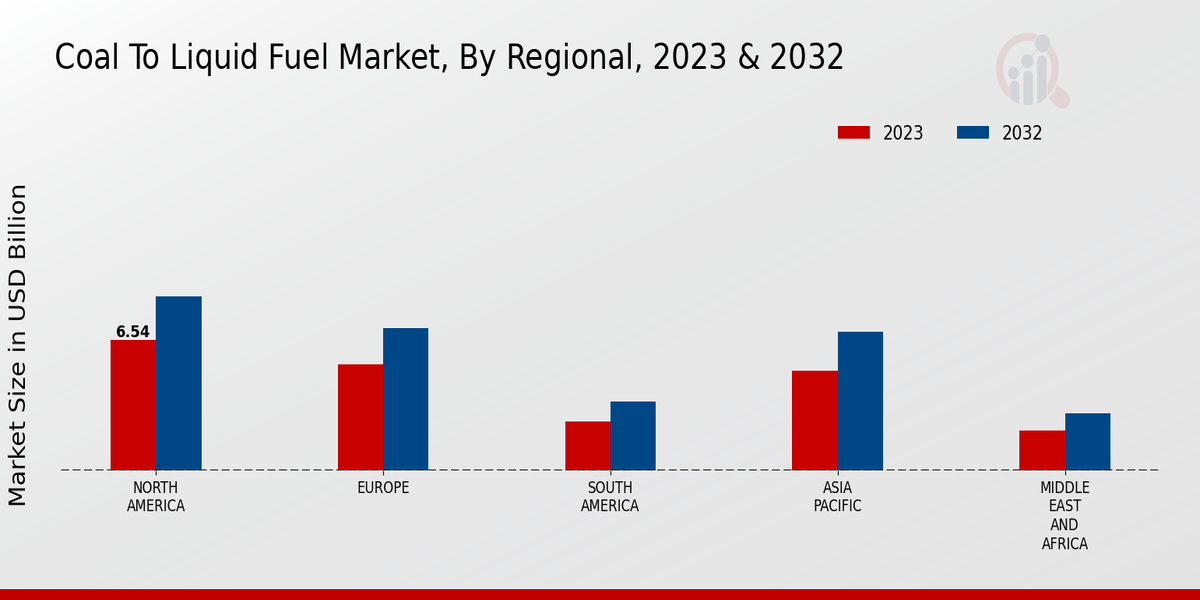Global Coal to Liquid Fuel Market Overview:
As per MRFR analysis, the Coal To Liquid Fuel Market Size was estimated at 22.79 (USD Billion) in 2024. The Coal To Liquid Fuel Market Industry is expected to grow from 23.60 (USD Billion) in 2025 to 32.25 (USD Billion) till 2034, at a CAGR (growth rate) is expected to be around 3.53% during the forecast period (2025 - 2034).
Key Coal to Liquid Fuel Market Trends Highlighted
The Coal to coal-to-liquid fuel market is projected to grow tremendously because it has the capability of transforming the most available and also the cheapest fuel, coal, into valuable fuels. This is being fueled by the desire by the governments to cut the use of oil earned from other nations and to make their energy sources greener than they currently are. In addition, in developing nations, there is a rising requirement for fuels used for transportation hence expanding the market.
The Coal to Liquid Fuel market lacks opportunities that include technological changes that can enhance the conversion processes and reduce harmful emissions. Other opportunities are based on the applications of Coal to Liquid fuels in sectors like aerospace and marine transport. The progressive development of new efficient technologies in coal gasification and liquefaction will be the new pathogens on the market.
However, the Coal to Liquid Fuel market has recently shown some positive trends whereby there is a move towards the adoption of less dirty and more effective conversion technologies. Steps are also being taken by governments to drive the use of various other forms of fuels, including Coal to Liquid fuel. With the carbon emission concerns in consideration, it is clear that the Coal to Liquid fuel market has a bright future, as energy consumption is inevitable in all aspects of the world today.

Source: Primary Research, Secondary Research, MRFR Database and Analyst Review
Coal to Liquid Fuel Market Drivers
Increasing Demand for Transportation Fuels
The transportation sector is the world’s biggest consumer of fossil fuels. As a result, alternative production methods have to be found to serve as substitutes for traditional petroleum-based fuels. Coal-to-liquid fuels can be harnessed to meet these emerging demands. The fuels can be used in all other applications normally carried out by their petroleum-based counterparts, including cars, trucks, and planes. The demand for transportation is bound to grow, and this will, in turn, birth a growing market for CTL fuels. Therefore, the Coal to Liquid Fuel Market Industry will experience strong growth in the near future.
Government Support for CTL Technologies
Governments all over the world are showing increasing support of CTL technologies. Several factors underlie this developing demand that led to the boom in the coal-to-liquid market. The government’s aim to reduce greenhouse gas emissions, to stabilize the need to import fuel from abroad, and to offer new jobs for their citizens. In the years to come, the government support of CTL technologies will only develop as rapidly, favoring the market for these CTL fuels.
Technological Advancements
Technological advancements are making CTL fuels more cost-effective and efficient to produce. These advancements include the development of new catalysts, process designs, and equipment. As CTL technologies continue to improve, the market for CTL fuels is expected to grow.
Coal to Liquid Fuel Market Segment Insights:
Coal to Liquid Fuel Market Feedstocks Insights
The Coal to Liquid Fuel Market segmentation by Feedstocks comprises Coal, Natural Gas, Petroleum Coke, and Biomass. Among these, Coal held the largest market share of 65% in 2023 and is projected to continue its dominance throughout the forecast period. The growth of the Coal segment can be attributed to the abundance and low cost of coal, making it an economically viable feedstock for CTL production. Natural Gas is another significant feedstock, accounting for 20% of the market in 2023. The demand for Natural Gas is driven by its cleaner combustion characteristics compared to coal and its increasing availability due to the development of unconventional gas resources.
Petroleum Coke, a byproduct of oil refining, is also used as a feedstock for CTL production, capturing around 10% of the market in 2023. The use of Petroleum Coke is expected to increase in the future as a means of waste utilization and value addition. Biomass, including plant materials and organic waste, is a renewable feedstock that has gained attention for CTL production due to its environmental benefits. The Biomass segment is projected to witness significant growth during the forecast period, driven by government incentives and the increasing adoption of sustainable energy sources.

Source: Primary Research, Secondary Research, MRFR Database and Analyst Review
Coal to Liquid Fuel Market Production Processes Insights
On average, the segment of production processes is the most influential one that determines the market’s dynamics. Fischer-Tropsch is currently the most attractive segment that makes up the most significant part of the market, as it is highly efficient and has a unique source that transforms into a vast array of hydrocarbons. The production process of Direct Coal Liquefaction will show the most impressive growth speed as it is fairly affordable and more eco-friendly. The segment of Indirect Coal Liquefaction, which is represented to a minimal extent, provides opportunities for developing new methods to improve performance.
Coal to Liquid Fuel Market Product Type Insights
The Coal to Liquid Fuel Market is segmented by product type into Gasoline, Diesel, Jet Fuel, and Synthetic Natural Gas. The Diesel segment held the largest market share in 2023, accounting for over 40% of the Coal to Liquid Fuel Market revenue. The Gasoline segment is expected to witness the highest growth rate over the forecast period, owing to the increasing demand for gasoline-powered vehicles in emerging economies. The Jet Fuel segment is also expected to grow at a significant rate, driven by the rising air travel demand. The Synthetic Natural Gas segment is expected to witness moderate growth due to its increasing use in power generation and industrial applications.
Coal to Liquid Fuel Market Application Insights
The Coal to Liquid Fuel Market is segmented by application into transportation, industrial, utilities, and residential sectors. The transportation segment is expected to account for the largest share of the market in 2023, owing to the increasing demand for transportation fuels such as gasoline and diesel. The industrial segment is expected to be the second largest segment, followed by the utilities and residential segments. In the transportation sector, Coal to Liquid fuel (CTL) is used as a substitute for conventional transportation fuels. CTL can be used in diesel engines, gasoline engines, and jet engines.
The demand for CTL in the transportation sector is expected to increase in the coming years due to the rising demand for transportation fuels and the increasing environmental concerns associated with the use of conventional fuels. In the industrial sector, CTL is used as a fuel for industrial boilers and furnaces. CTL can also be used as a feedstock for the production of chemicals and other products. The demand for CTL in the industrial sector is expected to increase in the coming years due to the growing demand for industrial products and the increasing environmental concerns associated with the use of conventional fuels.
In the utilities sector, CTL is used as a fuel for power plants. CTL can also be used as a feedstock for the production of electricity. The demand for CTL in the utilities sector is expected to increase in the coming years due to the growing demand for electricity and the increasing environmental concerns associated with the use of conventional fuels. In the residential sector, CTL is used as a fuel for heating homes and other buildings. CTL can also be used as a feedstock for the production of heat and hot water. The demand for CTL in the residential sector is expected to increase in the coming years due to the growing demand for heating and hot water and the increasing environmental concerns associated with the use of conventional fuels.
Coal to Liquid Fuel Market End-Use Market Insights
The End-Use Market segment of the Coal to Liquid Fuel Market is segmented into Automotive, Power Generation, Manufacturing, and Construction. The Automotive segment is expected to hold the largest market share in 2024, owing to the increasing demand for transportation fuels. The Power Generation segment is expected to be the second largest segment due to the rising demand for electricity. The Manufacturing and Construction segments are expected to grow at a steady pace, driven by the increasing demand for coal-based products in these industries.
Coal to Liquid Fuel Market Regional Insights
The regional segmentation of the Coal to Liquid Fuel Market showcases distinct market dynamics across various regions. North America holds a significant market share due to the presence of established coal reserves and ongoing investments in advanced CTL technologies. In 2023, the North American Coal to Liquid Fuel Market was valued at USD 6.54 billion and is projected to reach USD 8.32 billion by 2032, exhibiting a CAGR of 2.7%. Europe follows as a prominent regional market, driven by stringent environmental regulations and initiatives to reduce carbon emissions.
The European Coal to Liquid Fuel Market was valued at USD 5.29 billion in 2023 and is expected to grow at a CAGR of 3.1%, reaching a valuation of USD 6.78 billion by 2032. APAC is another significant region, with China leading the market due to its vast coal reserves and increasing demand for alternative fuels. The APAC Coal to Liquid Fuel Market was valued at USD 4.98 billion in 2023 and is projected to exhibit a CAGR of 4.2%, reaching a valuation of USD 6.62 billion by 2032. South America and MEA are emerging regional markets with untapped potential for CTL.
The South American Coal to Liquid Fuel Market was valued at USD 2.46 billion in 2023 and is expected to grow at a CAGR of 4.8%, reaching a valuation of USD 3.31 billion by 2032. The MEA Coal to Liquid Fuel Market was valued at USD 2.01 billion in 2023 and is projected to exhibit a CAGR of 5.6%, reaching a valuation of USD 2.74 billion by 2032.

Source: Primary Research, Secondary Research, MRFR Database and Analyst Review
Coal to Liquid Fuel Market Key Players And Competitive Insights:
The most important players in the Coal to Liquid Fuel Market industry invest in high-quality research and development to be ahead of the rivals operating in this domain. On the whole, such kind of an industry is extremely competitive, which is likely to define the further development of the sector. In addition to this, leading Coal to Liquid Fuel Market actors aim at expanding their presence in the market through collaboration and partnerships with the other dominant players.
Furthermore, the major market participants try to explore other existing and emerging markets to leverage new technologies and expand their presence. Additionally, an existing player with a considerable share of the Coal to Liquid Fuel Market is likely to benefit from the fact that the market is expanding actively and offers high growth opportunities for companies wishing to operate in the sector. The general model for such a market participant, as well as the relevant sectors, is provided below.
Sasol is one of the leading international integrated energy and chemicals companies working in the Coal to Liquid Fuel Market. Furthermore, the company is one of the major suppliers of the technology related to the said kind of fuel. Sasol is known for its technologies enabling coal to be converted into liquid fuel. These unique technologies developed by the company allow transforming coal into high-quality fuel, which can be used in this context.
Chevron is one of the major energy suppliers, which specializes in the exploration and production of the most environmentally friendly and high-quality crude oil and natural gas, as well as refining, marketing, transportation, and distribution. The company is an important provider of innovative Coal to Liquid Fuel Market technologies.
Key Companies in the Coal to Liquid Fuel Market Include:
- ConocoPhillips
- Sinopec
- Peabody Energy
- Sasol
- BP
- Valero Energy
- TotalEnergies
- China Shenhua Energy
- China National Offshore Oil Corporation
- PetroChina
- BHP
- Shell
- Marathon Petroleum
- Chevron
- ExxonMobil
Coal to Liquid Fuel Market Industry Developments
The Coal to Liquid Fuel Market is expected to witness steady growth from 2025 to 2034. Market growth is attributed to the increasing demand for transportation fuels and the need for cleaner energy sources. Government initiatives and regulations promoting the use of alternative fuels are also driving market growth. Technological advancements and the development of more efficient coal-to-liquid processes are expected to further contribute to market expansion. Recent developments in the market include the construction of new coal-to-liquid plants and the expansion of existing facilities. For instance, in 2023, China announced plans to build a new coal-to-liquid plant with an annual capacity of 4 million tons. Additionally, companies are investing in research and development to improve the efficiency and cost-effectiveness of coal-to-liquid processes.
Coal to Liquid Fuel Market Segmentation Insights
-
Coal to Liquid Fuel Market Feedstocks Outlook
- Coal
- Natural Gas
- Petroleum Coke
- Biomass
-
Coal to Liquid Fuel Market Production Processes Outlook
- Fischer-Tropsch
- Direct Coal Liquefaction
- Indirect Coal Liquefaction
-
Coal to Liquid Fuel Market Product Type Outlook
- Gasoline
- Diesel
- Jet Fuel
- Synthetic Natural Gas
-
Coal to Liquid Fuel Market Application Outlook
- Transportation
- Industrial
- Utilities
- Residential
-
Coal to Liquid Fuel Market End-Use Market Outlook
- Automotive
- Power Generation
- Manufacturing
- Construction
-
Coal to Liquid Fuel Market Regional Outlook
- North America
- Europe
- South America
- Asia Pacific
- Middle East and Africa
| Report Attribute/Metric |
Details |
|
Market Size 2024
|
22.79 (USD Billion)
|
|
Market Size 2025
|
23.60 (USD Billion)
|
|
Market Size 2034
|
32.25 (USD Billion)
|
|
Compound Annual Growth Rate (CAGR)
|
3.53% (2025 - 2034)
|
|
Report Coverage
|
Revenue Forecast, Competitive Landscape, Growth Factors, and Trends
|
|
Base Year
|
2024
|
|
Market Forecast Period
|
2025 - 2034
|
|
Historical Data
|
2019 - 2023
|
| Market Forecast Units |
USD Billion |
| Key Companies Profiled |
ConocoPhillips, Sinopec, Peabody Energy, Sasol, BP, Valero Energy, TotalEnergies, China Shenhua Energy, China National Offshore Oil Corporation, PetroChina, BHP, Shell, Marathon Petroleum, Chevron, ExxonMobil |
| Segments Covered |
Feedstocks, Production Processes, Product Type, Application, End-Use Market, Regional |
| Key Market Opportunities |
Increased demand from emerging economies Technological advancements Government policies Environmental concerns and Growing investment in coal-to-liquid projects |
| Key Market Dynamics |
Rising energy demand Concerns over oil supply Government initiatives Technological advancements |
| Countries Covered |
North America, Europe, APAC, South America, MEA |
Frequently Asked Questions (FAQ) :
The Coal to Liquid Fuel Market is expected to reach a valuation of USD 32.25 billion by 2034, expanding at a CAGR of 3.53% from 2025 to 2034.
North America is projected to dominate the Coal to Liquid Fuel Market throughout the forecast period. China is anticipated to be a significant contributor to the regional market growth owing to its increasing demand for transportation fuels and government initiatives to reduce dependence on imported crude oil.
Coal to Liquid Fuel finds applications in various sectors, including transportation, power generation, and industrial processes. It is primarily used as a substitute for conventional transportation fuels such as diesel and gasoline.
Key players in the Coal to Liquid Fuel Market include Sasol, Shell, China Shenhua Energy, and ExxonMobil. These companies are focusing on strategic collaborations, product innovations, and capacity expansions to gain a competitive edge.
The Coal to Liquid Fuel Market faces challenges such as high production costs, environmental concerns associated with coal mining and processing, and competition from alternative fuels like natural gas and renewables.
Emerging trends in the Coal to Liquid Fuel Market include technological advancements in coal gasification processes, the development of cleaner and more efficient technologies, and the increasing adoption of Coal to Liquid Fuel in transportation and industrial sectors.
Government regulations related to environmental protection and emission standards can significantly impact the Coal to Liquid Fuel Market. Governments are implementing policies to reduce carbon emissions and promote sustainable energy sources, which could affect the demand for Coal to Liquid Fuel.
The Coal to Liquid Fuel Market is anticipated to witness steady growth in the coming years, driven by increasing energy demand, technological advancements, and government initiatives to diversify energy sources.
The growth of the Coal to Liquid Fuel Market is primarily attributed to rising concerns over energy security, increasing demand for transportation fuels, and government support for alternative energy sources.
Potential risks associated with investing in the Coal to Liquid Fuel Market include fluctuations in coal prices, technological advancements in alternative fuels, and changes in government policies related to environmental regulations.

















